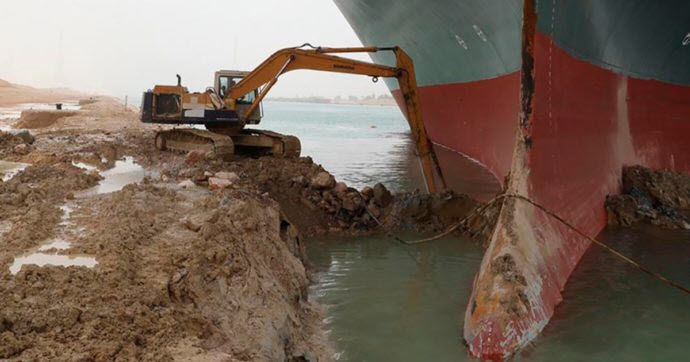Posted on October 14, 2021

By Paul Vanguard, for BullionMax.com
This time of year, we're planning our Halloween costumes and our Thanksgiving guest list. We're not near Christmas yet. And, like last year, it's probably not going to be as merry as the ones before.
But will there be anything under the tree this year?

That's according to the White House , by the way.
Here's a slightly more official description of the issue, via Reuters:
American consumers, unused to empty store shelves, may need to be flexible and patient, White House officials said.
"There will be things that people can't get," a senior White House official told Reuters, when asked about holiday shopping.
"At the same time, a lot of these goods are hopefully substitutable by other things. ... I don't think there's any real reason to be panicked, but we all feel the frustration and there's a certain need for patience to help get through a relatively short period of time."
So what exactly is going on?
Here's the thing: Inflation is currently running at a 30-year high . (Don't worry, this isn't another inflation rant; this is an unintended-consequences rant.)
And that's great news!
The White House argues inflation is a sign that their decision to provide historic support to small businesses and households, through $1.9 trillion in COVID-19 relief funding, worked.
Just kidding, it isn't great news. However, it did provide money for Americans to, as Wolf Richter puts it, spend " heroic amounts on goods ." When that "heroic amount" meets the reality of a world where thereisn't magically an equivalent amount of stuff for sale, prices go up. That's called "inflation."
Supply and demand. Economics 101 . (Khan Academy does a great job on this course, by the way. I wish our elected leaders were forced to learn at least the basics of economics before they start making decisions...)
This isn't a complete picture of the struggle, though. We don't only have heroic amounts of money to spend on goods vs. a finite quantity of goods.
No, it's just a smidge more complicated than that...
Supply chains. You know, nobody in the world (except for a few unappreciated workers) ever talked about "logistics" or "supply chains" until supermarkets ran out of toilet paper and hand sanitizer back in February 2020. Even then we blamed the problem on panic buying.
Even when we could all get toilet paper again, well, shortages didn't go away. Remember this?

Okay, it wasn't all the Ever Given's captain's fault. But this should remind us what a supply chain really is.
A supply chain is a series of interconnected services linked (see?) together that, cooperatively, manufacture and deliver a finished product.
Just to give you an idea of what a supply chain looks like, here's an example for a typical gold bullion coin:
Here's the thing: if at any point there's a delay, if the truck driver doesn't show up at the gold mine to take the smelted ore down the road to the refinery, the effects propagate down the chain. And the more links there are in a supply chain, the more points of failure there are…
Charles Hugh Smith covered this very succinctly:
These multitudes of intermediaries generate long dependency chains which break if even one link goes down. Every intermediary is a potential disruptor, and the more intermediaries there are, the more opportunities for one link in the chain to snap. With excess capacity kept near-zero to maximize profits, there's no slack, no pool of expertise to tap, no production capacity that can be turned on with a flick of a switch.
The global economy is still struggling out of the shadow of the Covid-19 pandemic. That means supplies are even tighter than before, which -- you guessed it -- reduces supply even though people have money and are desperate to spend it.
Increasing money supply while decreasing goods available adds to the inflationary pressure.
But don't worry, all this is temporary. Because we have a bottleneck czar now…
Seth Weathers, Trump's Georgia campaign advisor during the 2016 run, has this to say:
People here in Georgia are paying twice as much for items than they paid a year ago, and they are blaming Biden. He's in charge.
Maybe he's just trying to score political points on the other team? Still, the Biden administration isn't doing itself any favors…
Their defensive press conferences remind me of the way kids act when you walk into a messy room. Lots of finger pointing, many aspersions cast, voices increasingly shrill with different words but the same message: It's not my fault!
At least they've given up on calling this a "transitory" issue, dismissing global shortages of everything as a "blip" or a "snag." And it's only not a Christmas thing. The same problems have been going on for nearly two years and (as the White House reluctantly admits) are likely to continue.
But don't worry, Biden has a "bottleneck czar." He appointed John Pocari, a veteran transportation and logistics official. Pocari's take:
While the pandemic was an enormously disruptive force, I think it also laid bare what was an underlying reality, which was the system was strained before the pandemic.
So what's the solution?
You guessed it… Spending $3.5 trillion on infrastructure! You know, because the "system" was "strained."
There's one small problem. Even if that worked to improve the "system" it's going to take at least a decade. In other words, "That's kind of like planting an orchard to deal with hunger today," as Steve Lamar, CEO of the American Apparel & Footwear Association, told Reuters. His industry relies extensively on deliveries from Asia.
I'll say it: This is dumb. This is pure "If you have a hammer, every problem looks like a nail" thinking at its worst. Biden wants his infrastructure bill passed so badly that he's saying every problem can be solved with infrastructure.
Actually, "infrastructure" is just a buzzword. Universal pre-K and expanded federal healthcare programs and child tax credits and free college isn't "infrastructure."
The real solution Biden and his $3.5 trillion budget is pitching?
You can solve any problem by throwing more money at it.
We already threw lots of money ($5.4 trillion if memory serves) at the pandemic, and what did we get? Inflation at 30-year-highs.
So what happens if we spend even more money?
We know that inflation brings about ruin, as Weimar Germany and Zimbabwe and Venezuela have shown. So why are those who should have a nation's best interests in mind prioritizing it?
Keep in mind, these are the same people who think this:
The White House argues inflation is a sign that their decision to provide historic support to small businesses and households, through $1.9 trillion in COVID-19 relief funding, worked.
Folks, this is bad news, and not just for Christmas.
Now, you may be thinking: Is any of this going to affect gold's price in a meaningful way?
Well, demand is still higher than ever. Not quite as bad as the peak of the pandemic panic, but we seem to've reached a permanent plateau where we can expect higher demand for the foreseeable future.
And that means whoever leaves a gold coin or bullion bar under your Christmas tree really, really loves you.
Paul Vanguard is a lifelong precious metals enthusiast and a proud member of the BullionMax team.